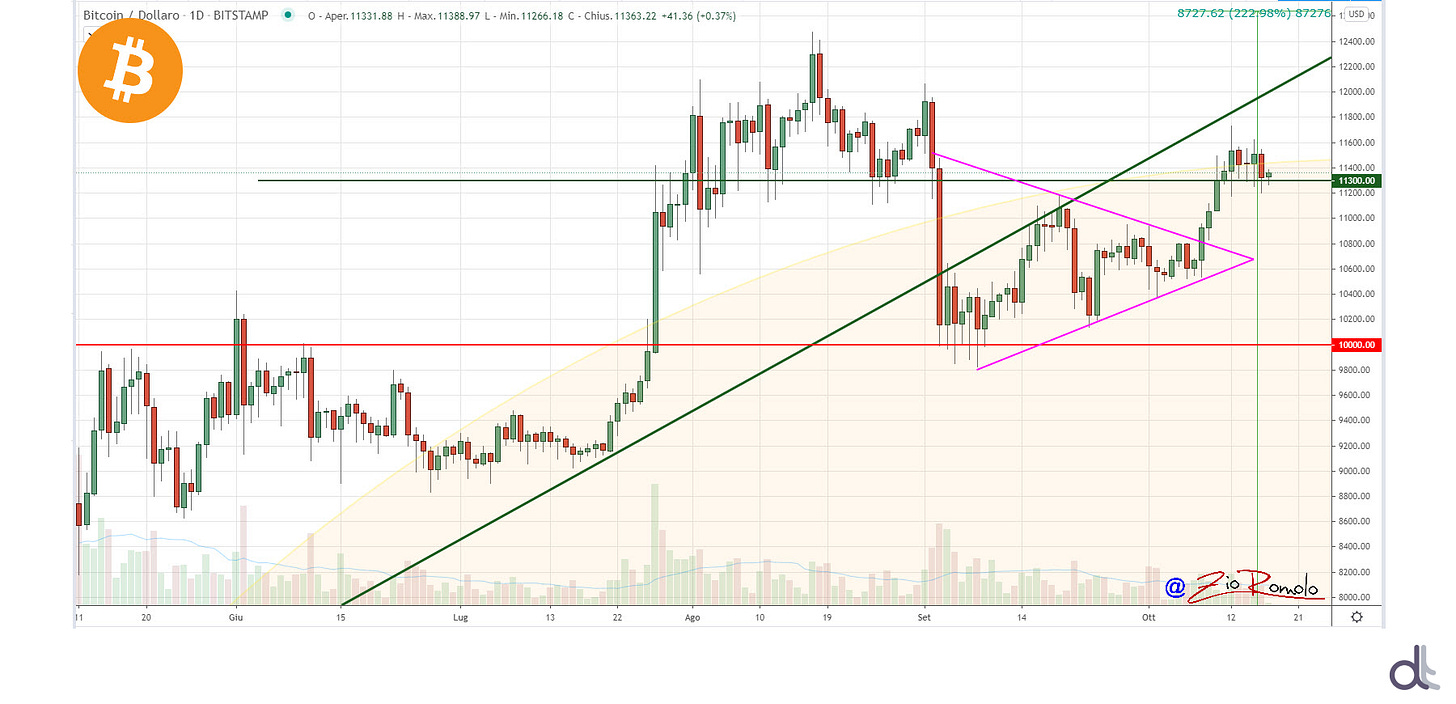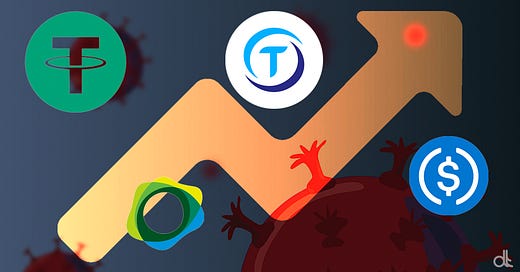Stablecoin Fever
Over the last week, the total marketcap for stablecoins exceeds $21B for the first time. Since the beginning of the Covid19 crisis (mid-March), the stablecoins cap has increased by 220%
At the end of April 2019, the Attorney General of New York, Letitia James, filed an indictment against iFinex Inc., a subsidiary of Tether Limited, with the New York Court at the end of April 2019, trying to prove that the Bitfinex exchange had secretly covered a loss shortfall of approximately $850 million by issuing Tether tokens without actual liquidity backing. The digital token Tether USDT is pegged to the US dollar with a 1:1 ratio and is created by holding the corresponding assets in circulation in the reserves of the issuing company Tether Limited.

Image source: Bitira
Since the first tokens were issued in October 2014, the entry and exit of traders has been made easier and faster both when trading between the various cryptocurrencies and for the flexibility offered in the management of trading within the exchanges, allowing quotations with an exchange rate against the US dollar. The news aroused concern not only for the fate of the exchange, at the time among the main traders, but also for a structural risk as several times the activity of the stablecoin Tether had been accused of influencing the prices of Bitcoin, in particular the rise that characterized the second half of 2017. Accusations that have been denied several times and never really proven but that have always catalyzed the attention and fears of cryptocurrency operators. In April 2019, the capitalization of Tether USDT stood at around $2.5 billion, or 80% of the share of the entire stablecoin market ($4 billion). With a daily average of over $16 billion, it held 97% of the total transaction volume.
18 months later, the battle between NYPD's indictment and iFinex & Co.'s defence is still ongoing, but things look decidedly different for the stablecoin industry. Tether USDT's capitalization is currently at $15.5 billion. An increase that started during the first Covid19 crisis. On March 20th, 2020, the USDT market cap was just over $4.5 billion. In five months, at the end of July, it had more than doubled, breaking the $10 billion barrier (on July 29th). With the same growth intensity but taking less time, on September 17th, total capitalization exceeded $15 billion in just two months. Currently more than 60% of Bitcoin trading activity is traded on USDT, and with an average of more than $3 billion traded (Messari data), Bitcoin's daily activity is double that of $1.5 billion.

Despite the massive growth of Tether USDT in recent months, competition has increased.
USDT's market share has now fallen from 80% to 75% with another stablecoin emerging in the ecosystem from 8% in June 2019 to 13% today.
This is USDCoin which is showing exponential growth, stronger in percentage and market terms. The USDC stablecoin was launched in September 2018 and, like USDT, is pegged to the US dollar. Supported by the Centre Consortium that provides the reserves, supported by Circle (which also obtained a round of funding from Goldman Sachs), the Coinbase exchange and the Bitmain miner company. The USDC market cap remained stable between $200 and $400 million for over a year. But since the end of March, like USDT, there has been a significant increase in demand, reaching an all-time high of $2.8 billion market cap in recent days. In these hours, the entire stablecoin market has for the first time exceeded $21 billion in total capitalization.
Decentralized Finance
While markets are still surrounded by uncertainty, the TVL (total value locked) reached an all-time high among decentralized financial projects of over $11.3 billion during the week.
Total Value Locked in DeFi

The Uniswap DEX (decentralized exchange) with over $2.6 billion consolidates the leadership among all decentralized projects.
Maker follows closely, almost exceeding the psychological threshold of $2 billion.
In third place, for the first time, a protocol in the asset category reaches the podium. With over 105,000 tokenized BTC, the WBTC are worth over $1.1 billion.
More than 159,500 bitcoin have been transformed into ERC20 tokens, setting new historical records almost daily. An increasing number of owners are choosing to deposit their bitcoin in the various yield farming projects offered by decentralized finance.
DEXes Volume

In the last seven days, the trading volume in decentralized finance has been $2.9 billion. 12% less than the previous week. The Uniswap DEX, with more than $2 billion traded since last Friday, or 69% of the entire turnover, remains the preferred project among traders.
ECB announced a public consultation on digital euro
Heath Tarbert (CFTC): “DeFi is revolutionary”
Almost 1M Ether would have been burnt in past year if fee proposal approved
Technical Analysis
by Federico Izzi
Bitcoin (BTC)
The rise above 11,200 USD puts an end to the sideways trend that for six weeks has kept prices caged between 10,000 and 11,100 USD. The breaking of the resistance caused many bearish positions to be covered, driving the prices back to 11,700 in a few hours, the first time since September 3rd. The lack of new purchases failed to sustain a further extension by allowing short term profit taking to prevail, rejecting the quotations and testing the former resistance at 11,200 USD, which has now become support. In the coming days, it will be necessary to consolidate the quotations above 11,000 USD in order to provide strength for the next upturn. Otherwise, it is important not to return below 10,200 USD, as this would invalidate the rise that began in early September.

Unlike last week, the strategy of options traders has changed. The strength of the put option hedges is doubled to protect against possible falls. The main strategies identify the area between the 9900 and 10450 as the levels to defend in order not to see a return of bearish strength. The first level most commonly referred to coincides with the $10,200 technical support.

Ethereum (ETH)
The week marked the return of purchases by raising prices above 390 USD after a month of ups and downs. The lack of confidence has deflated the purchases causing profit taking to prevail, with prices returning to the 360 USD area, a watershed level since the beginning of September. In spite of the uncertainty and the lack of volumes, fallen under the monthly average of $1 billion, the trend of Ethereum remains above the 325 USD area, where the bullish trendline that unites the increasing lows from the bottom of March passes. Only the break-down of this dynamic support would begin to give the first sign of medium-long term reversal.

Unlike Bitcoin, the strategies of options operators, who continue to fear a return of sales, remain unchanged. Upwards, hedges between 390 and 415 USD remain the same. These are the levels to be exceeded in order to attract new purchases. Downwards, it is important not to return below 325 USD in order not to increase the risk of bearish speculation.

PieDAO: Crypto ETFs Ray Dalio Style (+100% APY)
PieDAO’s take on DeFi ETFs is quite distinctive and worth looking at in greater detail. An ETF is a basket of assets (be it stocks, bonds, commodities, or crypto) that can be traded in a group. This allows investors to hedge risk PieDAO has already launched 4 ETF products and has many more in the works.
FOUR ETF PRODUCTS
DEFI+L gets you exposure to seven of the largest DeFi products (L for Large Market Capitalization).
DeFi+S is similar although, as you likely guessed, it gets you exposure to smaller, up and coming projects.These projects are typically less proven, but could have a greater upside potential.
BTC++ Gets you exposure to the four leading wrapped DeFi-friendly Bitcoin tokens.
USD++ Reminiscent of yUSD on yEARN, this gets you exposure to a basket of stablecoins, splitting your risk among them to limit your exposure.
One advantage of these ETFs vs DPI (DeFi Pulse Index) is the zero Streaming fee (like a management fee). Some of the ETFs, like DEFI+L, have a Swap Fee of 1%, this means that you as the ETF holder earn a little bit every time the portfolio is rebalanced. The fees are given to LPs (the holder of the ETF) and the swap fee is paid by the trader to rebalance the pie by trading inside it, in the first week DEFI+L has accrued close to $5,000 in swap fees only!

MINTING AND REDEEMING ASSETS
Another functionality that PieDAO features is the ability to Mint (add liquidity, from an assortment of the fund’s assets, or straight from Ether) or Redeem (remove liquidity from the ‘pie’ and claim the token allocations). We like this additional user empowerment straight from the UI.

LIQUIDITY MINING
Unlike the typical 50/50 Uniswap farming pools, Piedao is using Balancer 80/20 and 70/30 to mitigate impermanent loss.

You might have noticed the ‘See stake page’ APR on the DeFi+L Pool, you will need to enter the Stake page and connect MetaMask to see the APR on the DeFi+L Pool. Piedao use a time-based incentive program that rewards users who stay in longer (the longer duration that you remain staked, the more profitable it becomes in token terms).
DOUGH TOKEN
Like many other DeFi tokens on the market today, DOUGH will give you access to both their Governance and a portion of the Fees accrued on the platform. You can read more about the DOUGH token in greater detail in their Medium article.
Two innovations are particularly interesting, the first one is possibility for DOUGH holders to vote with the tokens inside the ETF. The second is the system of Automatic Buyback of DOUGH generated by the assets in the indexes and the DAO.

PROJECT POTENTIAL
Just this morning PieDAO launched ExperiPie (TPIE++) a new pool design with unlimited possibilities. The ExperiPie will be used to participate in governance protocols to benefit PieDao participants. Through the innovative and flexible nature of the pool it is possible to utilize active governance to take part in any yield farm opportunity.
There’s a lot to like about PieDAO. When you look into the proposals in their docs section you can see some innovative concepts for the crypto space, such as emulating Ray Dalio’s ‘All Weather Portfolio’ with crypto assets mixed in. I am excited to see how this protocol develops.
Watch the video here:



